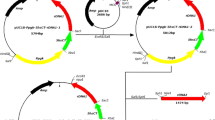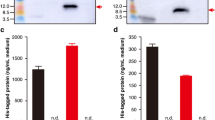Abstract
Oral delivery of salmon calcitonin (sCT) to rats via a recombinant Saccharomyces cerevisiae was assessed. A synthetic sCT gene was cloned and expressed in S. cerevisiae yAGA2-sCT. Recombinant salmon calcitonin (rsCT) expression was detected by flow cytometry. The resorption activity of osteoclasts was inhibited by 3 × 10−6 M rsCT. Oral administration of 5 g lyophilized yAGA2-sCT/kg to hypercalcemic rats decreased serum calcium from 2.8 ± 0.02–2.7 ± 0.02 mM.




Similar content being viewed by others
References
Beveridge T, Niederer W, Nuesch E, Petrin A (1976) Pharmacokinetic study with synthetic salmon calcitonin (Sandoz). Gastroenterol Verh 10:12–15
Blanquet S, Antonelli R, Laforet L, Denis S, Marol-Bonnin S, Alric M (2004) Living recombinant Saccharomyces cerevisiae secreting proteins or peptides as a new drug delivery system in the gut. J Biotechnol 110:37–49
Blanquet S, Marol-Bonnin S, Beyssac E, Pompon D, Renaud M, Alric M (2001) The biodrug concept: an innovative approach to therapy. Trends Biotechnol 19:393–400
Boder ET, Wittrup KD (1997) Yeast surface display for screening combinatorial polypeptide libraries. Nat Biotech 15:553–557
Cerrutti P, Segoviade M, Huergo M, Galvagno C, Schebor M, Buera DP (2000) Commercial baker’s yeast stability as affected by intracellular content of trehalose, dehydration procedure and the physical properties of external matrices. Appl Microbiol Biotechnol 54:575–580
Gietz RD, Woods RA (2002) Transformation of yeast by lithium acetate/single-stranded carrier DNA/polyethylene glycol method. Genet Mol Cell Biol 350:87–96
Hall JF, Webb TJB (1975) Factors affecting the survival of lyophilized brewery strains. J Inst Brew 81:471–475
Hirayama T, Sabokbar A, Itonaga I, Watt-Smith S, Athanasou NA (2001) Cellular and humoral mechanisms of osteoclast formation and bone resorption in Gorham-Stout disease. J Pathol 195:624–630
Horton RM, Ho SN, Pullen JK, Hunt HD, Cai Z, Pease LR (1993) Gene splicing by overlap extension. Methods Enzymol 217:270–279
Ivanov I, Tam J, Wishart P, Jay E (1987) Chemical synthesis and expression of the human calcitonin gene. Gene 59:22–30
Lakkakorpi P, Tuukkanen J, Hentunen T, Ja¨rvelin K, Va¨a¨na¨nen K (1989) Organization of osteoclast microfilaments during the attachment to bone surface in vitro. J Bone Miner Res 4:817–825
Lamprecht A, Yamamoto H, Takeuchi H, Kawashima Y (2004) pH-sensitive microsphere delivery increases oral bioavailability of calcitonin. J Control Release 98:1–9
McKee C, Gibson A, Dalrymple M, Emslie L, Garner I, Cottingham I (1998) Production of biologically active salmon calcitonin in the milk of transgenic rabbits. Nat Biotechnol 16:647–651
Pecherstorfer M, Brenner K, Zojer N (2003) Current management strategies for hypercalcemia. Treat Endocrinol 2:273–292
Sharp PM, Cowe E, Higgins DG, Shields DC, Wolfe KH, Wright F (1988) Codon usage patterns in Escherichia coli, Bacillus subtilis, Saccharomyces cerevisiae, Schizosaccharomyces pombe, Drosophila melanogaster and Homo sapiens; a review of the considerable within-species diversity. Nucleic Acids Res 16:8207–8211
Tsuruoka S, Sugimoto K, Fujimura A (2000) Contribution of diet to the dosing time-dependent change of vitamin D3-induced hypercalcemia in rats. Life Sci 68:579–589
Tuysuz B, Mercimek S, Ungur S, Deniz M (1999) Calcitonin treatment in osteoectasia with hyperphosphatasia (juvenile Paget’s disease): radiographic changes after treatment. Pediatr Radiol 29:838–841
Yamabe K, Kato Y, Onishi H, Machida Y (2003) Potentiality of double liposomes containing salmon calcitonin as an oral dosage form. J Control Release 89:429–436
Yoshina S, Ishida T, Noda H, Tomiya N (1996) A novel biologically active eel calcitonin analogue with carboxyl terminal Hse32-amide: carboxyl terminal Pro32-amide in calcitonin is not essential for biological activity. Biochem Mol Biol Int 40:923–929
Zaidi M, Inzerillo AM, Moonga BS, Bevis PJR, Huang CLH (2002) Forty years of calcitonin–where are we now? A tribute to the work of Iain Macintyre, FRS. Bone 30:655–663
Acknowledgements
This work was supported by the National ‘863’ Project of the State Science and Technology Commission of China (819-04-10).
Author information
Authors and Affiliations
Corresponding author
Rights and permissions
About this article
Cite this article
Sun, P., Zhang, X., Zang, X. et al. Anti-hypercalcemic effect of orally administered recombinant Saccharomyces cerevisiae expressing salmon calcitonin on hypercalcemic rats. Biotechnol Lett 29, 1013–1018 (2007). https://doi.org/10.1007/s10529-007-9352-3
Received:
Revised:
Accepted:
Published:
Issue Date:
DOI: https://doi.org/10.1007/s10529-007-9352-3




